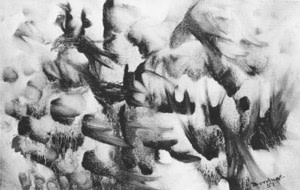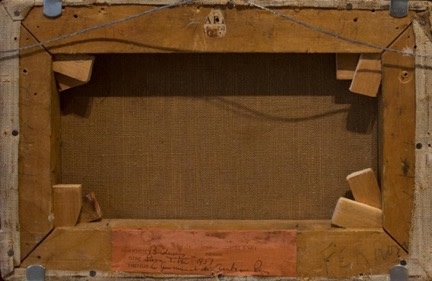At last, free to paint! Borduas’s "Untitled" and the liberty of automatism

Paul-Émile Borduas, Untitled, 1951
Oil on canvas, 19,68 x 40,48 cm
When confronted to an unusual Borduas painting recently appearing on the market, one the best source to establish its authenticity is to consult the Borduas files at the Archives of the Musée d'art contemporain in Montreal. Some files in this huge documentation contain photos of his painting taken or by himself or by professional photographer like Philipp Poccock, from Ottawa, who used to work for the magazine Canadian Art. He visited Borduas in Paris in May 1957. Indeed, there is a black and white photo of our painting in file 225 at the Musée d'art contemporain. But dating from 1951, the photo was probably taken by Borduas himself.

Black and white photo of Sans titre, 1951 in file 225, Borduas Archives, MAC, Montreal
A painting is also an object that has its own history. We know that the actual collector acquired it "long time ago" from the Simon Dresdnere Gallery, which had a Montreal address (2170 Crescent Street) in the sixties. But the back of the painting gives us two more intriguing clues.

A label on the lower sub-frame claims that "Le Gouvernement du Québec" in "Paris" is the "PRÊTEUR" of this painting! Of this information, we could not make much sense. But at the same level, on the right, one can read in big letters: "FERRON", of course for the painter Marcelle Ferron, with whom Borduas was in contact during his Parisian period (1955-1960). Could it be that Marcelle Ferron was the one who brought back this painting in Canada, and put it in consignation at Dresdnere? We don't know for sure, but is an interesting possibility.
The unusual character of this small painting is not so much its size, but the fact that it is so thinly painted. One has to recall that 1950 - 1951 was a period when Borduas produced many watercolors, and our painting is one the rare to show such an influence of the watercolor on the oil paintings of that period. One sees even here and there some running effects due to the usage in excess of the oil medium. More, the branching forms on the right and the general movement of the spots in the painting could find an echo in some watercolors of the 1950, like Sombre machine d'une nuit de fête, 1950 or Le Vent d'ouest apporte des chinoiseries de porcelaine, 1950[1].
1951 was not a very happy year for Borduas. He was dismissed from his work in École du meuble, since three years already, after the publication of the manifesto Refus global in 1948, and has practically to live him and his family, exclusively from the sale of his paintings. This explains his interest in works on paper, easier to sale than big oil painting, and probably the small size of our painting. 1951 saw also a new interest of Borduas in sculpture. He exhibited them at his Saint-Hilaire studio (June 2 to 4), with some oil and watercolors. In October 13 to 26, the Picture Loan Society showed his "Color Ink Paintings" in Toronto. Nevertheless, his hardship in making a living started to put a stress on his marriage. He could not accept that his wife could go back to her nurse job, a remnant of a male chauvinistic attitude, astonishing from a man like the "revolutionary" Borduas!
If we had only our Sans titre, 1951, nothing of this hardship could be felt in the free handling of the painting, in the contrast of blue and brown, in the gentleness and movement of the whole composition. One should not always assume a correspondence between the biography of a painter and the look of his work. Painting is also a way to escape from the necessity of life. Automatism, appealing from the unconscious, encouraged this kind of liberty. Dreams are not always nightmares. Done without any pre-conceived idea, our Sans titre reminds us of the first lines of Projections libérantes, the autobiographical pamphlet published by Borduas in 1949 .
A reprieve is granted from the black misery to come. (...) The idea of a vacation haunts me. It manifests an old echo: at last, free to paint!
Are we not feeling it in this particular painting?
[1] Reproduced in color in my book, Paul-Émile Borduas. A Critical Biography, McGill-Queen's University Press, Montreal & Kingston, London, Ithaca, 2015, respectively on page 281 and 283.




